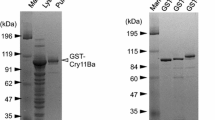Abstract
A Cry46Ab toxin derived from Bacillus thuringiensis strain TK-E6 shows mosquitocidal activity against Culex pipiens pallens Coquillett (Diptera: Culicidae) larvae as well as preferential cytotoxicity against human cancer cells. In B. thuringiensis cells, Cry46Ab is produced and accumulates as a protein crystal that is processed into the active 29-kDa toxin upon solubilization in the alkaline environment of the insect midgut. The Cry46Ab protoxin is 30 kDa, and is therefore thought to require an accessory protein such as P20 and/or ORF2 for efficient crystal formation. In the present study, the potency of the 4AaCter-tag was investigated for the production of alkali-soluble inclusion bodies of recombinant Cry46Ab in Escherichia coli. The 4AaCter-tag is a polypeptide derived from the C-terminal region of the B. thuringiensis Cry4Aa toxin and facilitates the formation of alkali-soluble protein inclusion bodies in E. coli. Fusion with the 4AaCter-tag enhanced both Cry46Ab production and the formation of Cry46Ab inclusion bodies. In addition, upon optimization of protein expression procedures, the Cry46Ab–4AaCter inclusion bodies showed mosquitocidal activity and stability in aqueous environments comparable to Cry46Ab without the 4AaCter-tag. Our study suggests that use of the 4AaCter-tag is a straightforward approach for preparing formulations of smaller-sized Cry toxins such as Cry46Ab in E. coli.





Similar content being viewed by others
References
Agaisse H, Lereclus D (1995) How Bacillus thuringiensis produce so much insecticidal crystal protein? J Bacteriol 177:6027–6032
Akiba T, Abe Y, Kitada S, Kusaka Y, Ito A, Ichimatsu T, Katayama H, Akao T, Higuchi K, Mizuki E, Ohba M, Kanai R, Harata K (2009) Crystal structure of the parasporin-2 Bacillus thuringiensis toxin that recognizes cancer cells. J Mol Biol 386:121–133. https://doi.org/10.1016/j.jmb.2008.12.002
Aronson AI, Han ES, McGaughey W, Johnson D (1991) The solubility of inclusion proteins from Bacillus thuringiensis is dependent upon protoxin composition and is a factor in toxicity to insects. Appl Environ Microbiol 57:981–986
Bietlot HP, Vishnubhatla I, Carey PR, Pozsgay M, Kaplan H (1990) Characterization of the cysteine residues and disulphide linkages in the protein crystal of Bacillus thuringiensis. Biochem J 267:309–315
Chak KF, Ellar DJ (1987) Cloning and expression in Escherichia coli of an insecticidal crystal protein gene from Bacillus thuringiensis var. aizawai HD-133. J Gen Microbiol 133:2921–2931. https://doi.org/10.1099/00221287-133-10-2921
Du C, Martin PAW, Nickerson KW (1994) Comparison of disulfide contents and solubility at alkaline pH of insecticidal and noninsecticidal Bacillus thuringiensis protein crystals. Appl Environ Microbiol 60:3847–3853
Finney DJ (1971) Probit analysis, 3rd edn. Cambridge University Press, London
Hayakawa T, Kanagawa R, Kotani Y, Kimura M, Yamagiwa M, Yamane Y, Takebe S, Sakai H (2007) Parasporin-2Ab, a newly isolated cytotoxic crystal protein from Bacillus thuringiensis. Curr Microbiol 55:278–283. https://doi.org/10.1007/s00284-006-0351-8
Hayakawa T, Howlader MTH, Yamagiwa M, Sakai H (2008) Design and construction of a synthetic Bacillus thuringiensis Cry4Aa gene-Hyperexpression in Escherichia coli. Appl Microbiol Biotechnol 80:1033–1037. https://doi.org/10.1007/s00253-008-1560-9
Hayakawa T, Sato S, Iwamoto S, Sudo S, Sakamoto Y, Yamashita T, Uchida M, Matsushima K, Kashino Y, Sakai H (2010) Novel strategy for protein production using a peptide tag derived from Bacillus thuringiensis Cry4Aa. FEBS J 277:2883–2891. https://doi.org/10.1111/j.1742-4658.2010.07704.x
Hayakawa T, Sakakibara A, Ueda S, Azuma Y, Ide T, Takebe S (2017) Cry46Ab from Bacillus thuringiensis TK-E6 is a new mosquitocidal toxin with aerolysin-architecture. Insect Biochem Mol Biol 87:100–106. https://doi.org/10.1016/j.ibmb.2017.06.015
Hayashi M, Iwamoto S, Sato S, Sudo S, Takagi M, Sakai H, Hayakawa T (2013) Efficient production of recombinant cystatin C using a peptide-tag, 4AaCter, that facilitates formation of insoluble protein inclusion bodies in Escherichia coli. Protein Expr Purif 88:230–234. https://doi.org/10.1016/j.pep.2013.01.011
Laemmli UK (1970) Cleavage of structural proteins during the assembly of the head of bacteriophage T4. Nature 227:680–685
Lecadet MM (1967) Action comparée de l’urée et du thioglycolate sur la toxine figurée de Bacillus thuringiensis. C R Acad Sci Hebd Seances Acad Sci D 264:2847–2850
Matsumoto R, Shimizu Y, Howlader MT, Namba M, Iwamoto A, Sakai H, Hayakawa T (2014) Potency of insect-specific scorpion toxins on mosquito control using Bacillus thuringiensis Cry4Aa. J Biosci Bioeng 117:680–683. https://doi.org/10.1016/j.jbiosc.2013.12.004
Nickerson KW (1980) Structure and function of the Bacillus thuringiensis protein crystal. Biotechnol Bioeng 22:1305–1333. https://doi.org/10.1002/bit.260220704
Oeda K, Oshie K, Shimizu M, Nakamura K, Yamamoto H, Nakayama I, Ohkawa H (1987) Nucleotide sequence of the insecticidal protein gene of Bacillus thuringiensis strain aizawai IPL-7 and its high-level expression in Escherichia coli. Gene 53:113–119
Schnepf E, Crickmore N, Van Rie J, Lereclus D, Baum J, Feitelson J, Zeigler DR, Dean DH (1998) Bacillus thuringiensis and its pesticidal crystal proteins. Microbiol Mol Biol Rev 62:775–806
Yu J, Xie R, Tan L, Xu W, Zeng S, Chen J, Tang M, Pang Y (2002) Expression of the full-length and 3′-spliced cry1Ab gene in the 135-kDa crystal protein minus derivative of Bacillus thuringiensis subsp. kyushuensis. Curr Microbiol 45:133–138. https://doi.org/10.1007/s00284-001-0092-7
Acknowledgements
Culex pipiens eggs were kindly supplied by the Research and Development Laboratory at Dainihon Jochugiku, Osaka, Japan. This work was supported by the Japan Society for the Promotion of Science KAKENHI (grant nos. JP24380034 and JP26660268).
Author information
Authors and Affiliations
Corresponding author
Rights and permissions
About this article
Cite this article
Okazaki, T., Ichinose, J., Takebe, S. et al. Potency of the mosquitocidal Cry46Ab toxin produced using a 4AaCter-tag, which facilitates formation of protein inclusion bodies in Escherichia coli . Appl Entomol Zool 53, 67–73 (2018). https://doi.org/10.1007/s13355-017-0529-5
Received:
Accepted:
Published:
Issue Date:
DOI: https://doi.org/10.1007/s13355-017-0529-5




